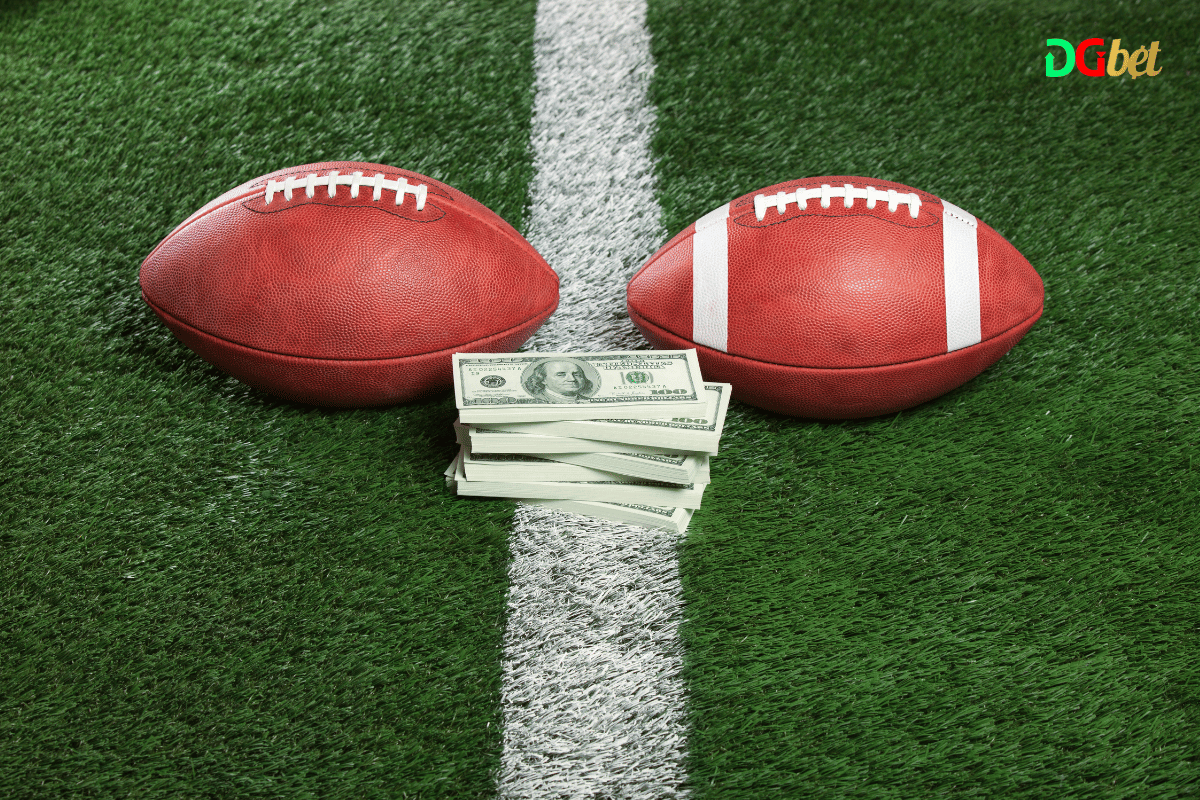Are you ready to make game-day decisions like a pro without even breaking a sweat? Grab your lucky jersey, because we’re diving into the world of NFL moneyline betting!
Football enthusiasts and betting newcomers alike often find themselves attracted to the simplicity of NFL moneyline betting. This type of wager asks a straightforward question: Which team will win? However, understanding the nuances of moneyline odds, and how potential payouts and risks work, can be a bit perplexing.
In this blog about moneyline in NFL betting, you’ll gain a solid understanding of how to read NFL moneyline odds, the impact of betting on favorites versus underdogs, and effective strategies to help you make informed decisions. Whether you’re curious about payout calculations or how moneylines compare to spread betting, this guide covers all you need to know.
For a more hands-on approach in real-time betting, platforms like DGbet offer an excellent environment to test your newly acquired knowledge.
What Is The NFL Moneyline?
NFL moneyline betting is one of the simplest forms of sports wagering. The basic question it revolves around is: Who is going to win?
This means you would have to wager $150 to win $100. On the other hand, the team with positive odds (like +130) is the underdog. Here, a $100 bet would return $130 if the underdog wins.
Take, for example, a game between the New England Patriots and the Miami Dolphins. The Patriots are listed at -200, while the Dolphins are at +170. If you believe the Patriots will win, you’d need to bet $200 to make a $100 profit. Conversely, if you think the Dolphins will pull off an upset, a $100 bet would give you a $170 profit if they win.
Moneyline betting is attractive for its simplicity, making it ideal for both beginners and pros.
Here is a youtube video which will provide you with a general overview and understanding of what a moneyline bet is, and additional concepts that are essential for first timers. https://www.youtube.com/watch?v=L4aXn9w-eVc
How To Understand NFL Moneyline Odds?
At first glance, NFL moneyline odds can seem tricky, but once you get the basics, they’re actually pretty simple!
American odds use a plus (+) or minus (-) sign to show you who’s the underdog and who’s the favorite:
- Plus Sign (+): This shows the underdog. The number after the plus tells you how much profit you’ll make on a $100 bet. For example, if the Cincinnati Bengals have odds of +185, a $100 bet will give you $185 in profit if they win.
- Minus Sign (-): This shows the favorite. The number after the minus tells you how much you need to bet to win $100. So, if the Los Angeles Rams have odds of -217, you need to bet $217 to make a $100 profit.
Example:
- Rams -217: The Rams are the favorite. You need to bet $217 to win $100.
- Bengals +185: The Bengals are the underdog. A $100 bet on them will earn you $185 if they win.
The bigger the minus number, the more likely the team is to win, while a larger plus number means a bigger potential profit if the underdog pulls off an upset.
DGbet provides intuitive tools and resources to help you get accustomed to these odds quickly.
How to find the likelihood of a team winning?
You can also use moneyline odds to estimate how likely it is for a team to win. This is called implied probability, and it helps you make smarter bets. Here’s how to figure it out:
- For favorites (negative odds), use this formula:
For example, if the Rams are -217, their implied probability of winning is:
This means the Rams have a 68.5% chance of winning.
- For underdogs (positive odds), use this formula:
For the Bengals at +185, their implied chance of winning is:
So, the Bengals have a 35.1% chance of winning.
Understanding these percentages can help you balance risk and reward when deciding which team to bet on!
Betting On NFL Moneyline: Favorites vs. Underdogs
Here’s a quick breakdown of the key differences and strategies for betting on favorites and underdogs in NFL moneyline betting:
Betting on favorites: The safe but small return option
- Win rate: NFL favorites win 81.2% of the time, with home favorites winning 78.6% of games this season.
- Reliability: Betting on favorites is generally considered safer because they are more likely to win.
- Payout: Lower odds mean smaller returns. For example, a team favored by 2 points won’t offer much of an edge, and the ROI for betting on favorites is only 0.8% over the past decade.
- Risk: You have to wager more to make a decent profit, so one loss can hit your bankroll hard.
Betting on underdogs: High risk, High reward
- Win rate: Underdogs win less often but cover the spread 60.19% of the time when playing on the road.
- Payout: When underdogs win, the payout can be significant because the odds are higher. A betting strategy on road underdogs between 2.5 to 6.5-point underdogs has returned +62.26 units since 2007.
- Public influence: Since most bettors prefer favorites, underdog odds often increase, making these bets more valuable.
- Risk: They win fewer games, but the occasional win can lead to much larger payouts than favorites offer.
The role of public betting & bookmaker adjustments
- Public bias: Bettors tend to lean toward favorites, leading bookmakers to adjust odds to balance bets.
- Opportunity: Bookmakers may raise underdog odds to attract more bets, which can create an opening for smart bettors.
- Strategy: Track public betting patterns and odds changes across multiple sportsbooks. This can help you find the best odds for both favorites and underdogs.
Strategic tips for betting on NFL moneylines
- Evaluate factors: Consider things like home-field advantage and recent team performance when deciding to bet on a favorite or an underdog.
- Be cautious with favorites: Despite their higher chances of winning, the low payouts can make a single loss costly.
- Balance your bets: Mixing favorites and underdogs, based on value and timing, can improve your long-term success.
How To Calculate NFL Moneyline Payouts?
Now that you know how to read moneyline odds and the difference between favorites and underdogs, let’s talk about how to calculate your payouts. It may sound a bit complex, but once you get the hang of it, it’s pretty straightforward!
Basic Calculation
To figure out how much you’ll win, just multiply the odds by your bet amount. The formula changes a little depending on whether the odds are positive or negative.
- For negative odds (favorites):
- For positive odds (underdogs):
Examples
Let’s look at a couple of real-world examples:
- Team A at -120 odds, and you place a $50 bet:
If you win, yout total payout is:
$50 (stake) + $41.67 (profit) = $91.67
- Team B at +330 odds, with the same $50 bet:
If Team B wins, your total payout would be:
$50 (stake) + $165 (profit) = $215
Using online calculators
If math isn’t your strong suit or you want to save time, there are plenty of online calculators that do the heavy lifting for you. These tools can also calculate implied probabilities and give you detailed payout info in seconds, making your betting experience much easier!
Understanding NFL Moneyline Strategies
When it comes to betting on NFL games, you’ve got two main options: moneyline betting and spread betting. Let’s break down what these mean and how they can work in your favor.
Moneyline betting vs. Spread betting
- Moneyline betting: This is as simple as it gets. You’re just betting on which team will win. It’s perfect for both beginners and experienced bettors because there are no complicated point systems involved.
- Spread betting: In this type of bet, you’re not just picking a winner—you’re betting on whether a team will win by a certain number of points (the spread). For example, if a team is favored by 7 points, they need to win by more than 7 for you to win your bet. Spread betting levels the playing field and can make both teams an appealing option, even if one is heavily favored.
Comparing moneyline and spread betting: Pros and Cons
| Betting Type | Pros | Cons |
| Moneyline Betting | Simplicity: Easy to understand, just pick the winning team. | Lower Payouts for Favorites: Smaller returns when betting on favorites. |
| No Point Spread: No need to worry about the margin of victory. | ||
| Spread Betting | Balanced Odds: Point spreads make both teams appealing. | More Complex: Requires understanding how point spreads work. |
| Higher Payouts: Potential for bigger returns with value in the spread. | Increased Risk: Favorites must not only win but also cover the spread, adding risk. |
When to choose moneyline over spread betting?
Here are a few scenarios where moneyline bets might be your best choice:
- Strong favorites: If you believe a team will win, but aren’t sure they’ll cover a large spread, moneyline betting is safer because you’re only betting on the win, not the margin.
- Close games: When two teams are closely matched, a moneyline bet can be appealing. Since predicting the winner is already difficult, adding a point spread can make things unnecessarily complicated.
- For beginners: Moneyline betting is easy to understand, making it perfect for people who are new to sports betting.
Understanding when to use moneyline vs. spread betting and how to calculate payouts will make a big difference in your overall success!
On DGbet, you can easily switch between different types of bets and leverage these strategies to your advantage.
Conclusion
NFL moneyline betting is your ticket to easy, thrilling wagers—just pick the winner! But if you want to up your game, knowing what moneyline is in NFL betting is only the start. Whether you’re backing the favorite for a safe win or chasing big rewards by betting on underdogs, mastering the odds and payout strategies is where the real fun begins. The beauty of moneyline betting lies in its simplicity, but the potential for smart, calculated risks can make it truly rewarding. With the right insights, your next bet could be a game-changer!






